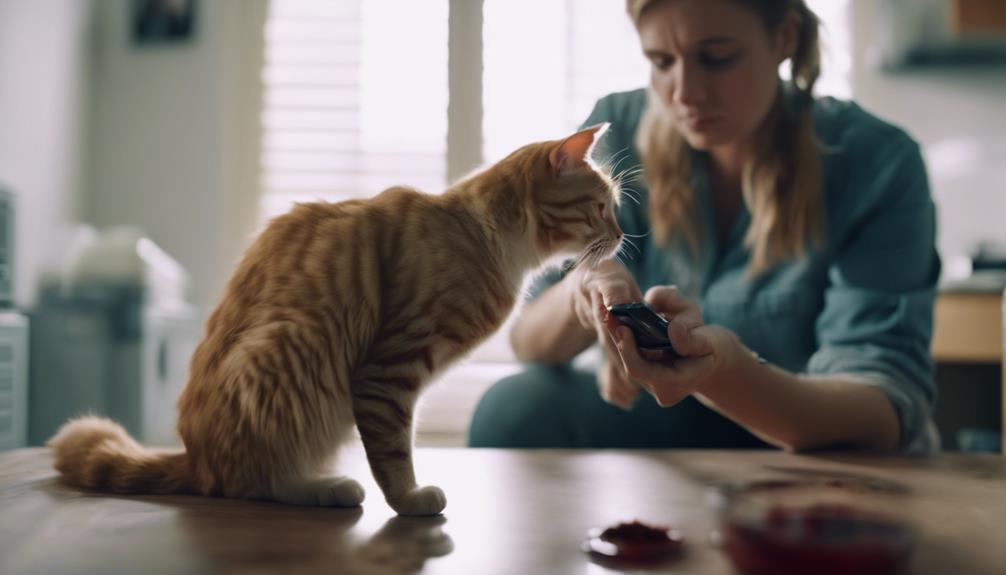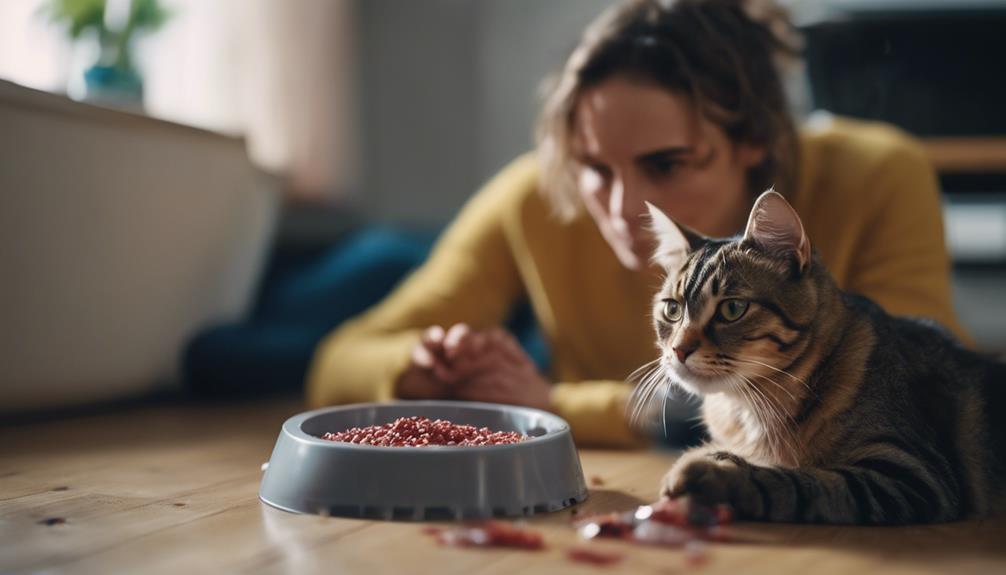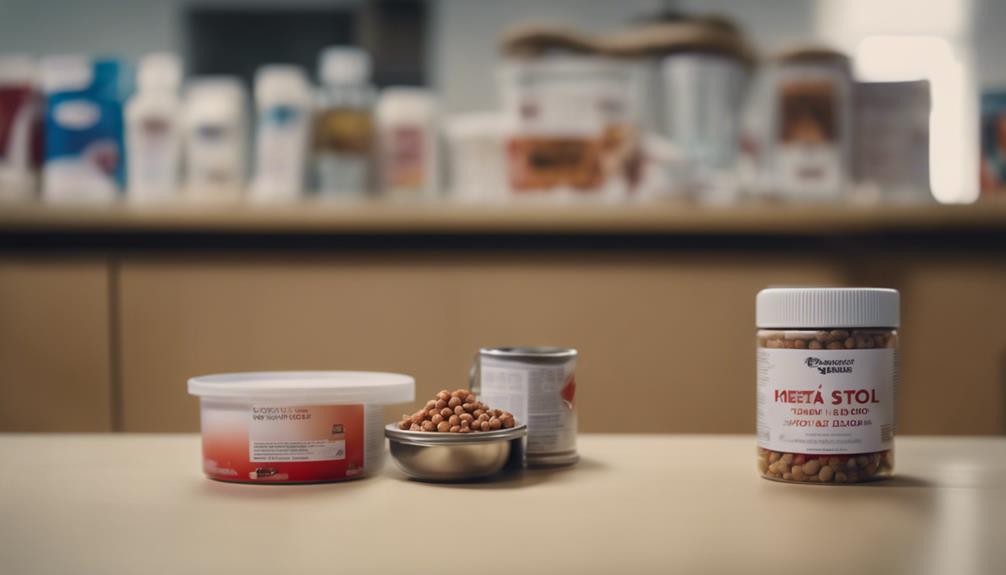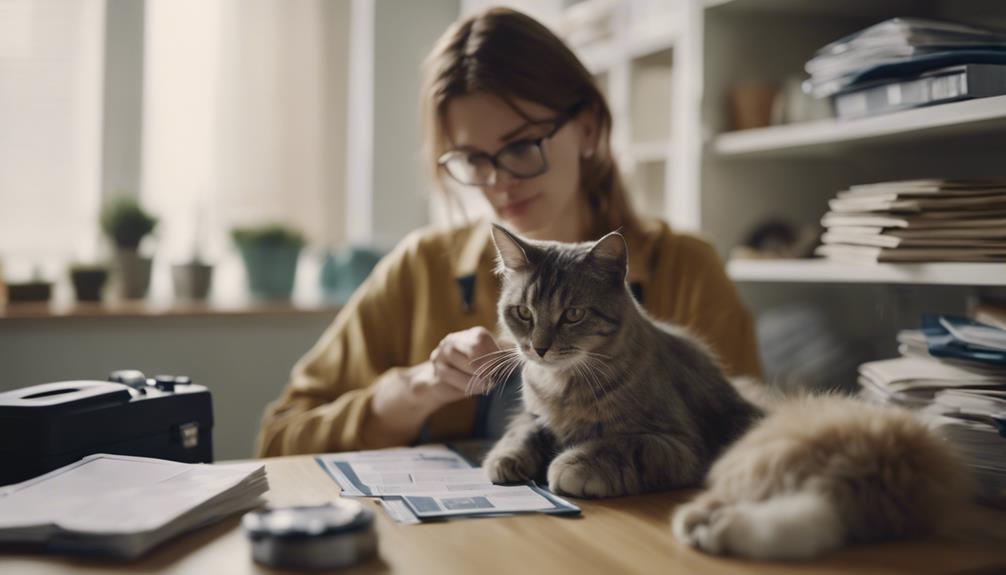Recognizing blood in your cat's stool can be alarming, prompting concerns about their health and well-being. Understanding the potential causes behind this issue is vital for taking appropriate action to help your pet.
By being proactive and informed, you can ensure prompt care and intervention when needed. Stay tuned as we explore the steps you can take to address this situation effectively and safeguard your feline companion's health.
Key Takeaways
- Monitor your cat's behavior and stool, documenting symptoms for vet assessment.
- Immediate vet attention needed for signs like lethargy, vomiting, or persistent diarrhea.
- Dietary adjustments may help temporarily, but vet consultation is crucial.
- Regular vet check-ups advised for cats with occasional blood in their stool.
Identifying Blood in Cat's Stool
When identifying blood in your cat's stool, observe for signs of fresh or bright red blood in the poop, diarrhea, or around the cat's anus as an indication of potential health concerns. Fresh blood may suggest issues in the large intestine or rectum. It is essential to monitor your cat's stool regularly for any abnormality.
Changes in color, consistency, or the presence of blood warrant attention. Keep an eye out for any accompanying symptoms like lethargy, vomiting, or a change in appetite. While occasional blood in the stool might not be alarming, persistent occurrences should prompt a veterinary visit to rule out any serious underlying conditions.
Your vigilant observation and prompt action can aid in maintaining your cat's health and well-being.
Causes of Blood in Stool
Blood in your cat's stool can be caused by various factors, including trauma, infections, and inflammatory bowel disease. Understanding the potential causes can help you assist your feline companion effectively. Here is a breakdown of some common reasons for blood in your cat's stool:
| Causes of Blood in Stool | Description |
|---|---|
| Trauma | Can result from constipation or colitis. |
| Infections | Bacterial or viral infections in the digestive system. |
| Inflammatory Bowel Disease | Chronic inflammation affecting the intestines. |
| Intestinal Parasites | Worms or other parasites residing in the gastrointestinal tract. |
| Cancer | Tumors in the digestive system or related organs. |
Be vigilant and seek veterinary care promptly if you notice blood in your cat's stool to ensure timely intervention and treatment.
Symptoms of Feline Urinary Problems

Feline urinary problems can manifest through various noticeable symptoms indicating potential health issues in cats. Common signs of urinary problems in felines include frequent urination, straining to urinate, blood in the urine, urinating outside the litter box, vocalization while urinating, and licking the genital area excessively.
Cats with urinary issues may also display signs of pain, such as crying out when trying to urinate or displaying aggression when touched near their abdomen. Changes in the urine's appearance, like cloudiness or a strong odor, can also indicate a problem.
If you notice any of these symptoms, it is essential to seek veterinary care promptly to diagnose and treat the underlying cause of your cat's urinary issues.
Signs of Upper Gastrointestinal Disease
Symptoms of upper gastrointestinal disease in cats can vary in their presentation, indicating potential health issues that require veterinary attention.
- Chronic vomiting or regurgitation after meals may point to upper GI problems.
- Cats displaying signs of discomfort or pain around their abdomen could be experiencing issues in the upper digestive tract.
- Changes in appetite, such as decreased interest in food or reluctance to eat, might be linked to upper gastrointestinal complications.
Actions to Take for Cat's Health

Chronic vomiting or regurgitation after meals in cats can indicate upper gastrointestinal issues that necessitate prompt veterinary evaluation to ensure optimal feline health. If you notice blood in your cat's stool, it's crucial to take immediate action for your pet's well-being.
Start by capturing pictures and monitoring your cat's behavior closely. Document any symptoms over a few days to provide the vet with a comprehensive view of your cat's health. Watch for signs that require immediate attention within 24-72 hours, such as lethargy, straining to eliminate, vomiting, unusual stool odor, or loss of appetite or thirst.
Persistent diarrhea, hard stool for more than two days, or no stool elimination for two days are red flags that should not be ignored.
Behavioral Monitoring and Picture Capturing
When observing your cat for signs of health issues, it is advisable to engage in behavioral monitoring and capture pictures to aid in documenting any changes or abnormalities.
- Behavioral Monitoring: Pay attention to your cat's eating habits, litter box usage, and activity levels.
- Picture Capturing: Take clear photos of your cat's stool with visible blood, as well as any unusual behaviors or physical changes.
- Consistent Observation: Regularly monitor your cat's behavior and stool appearance to track any variations or improvements.
Documenting Symptoms for Veterinary Assessment

For an accurate veterinary assessment, thorough documentation of your cat's presenting signs and any accompanying changes is crucial. Keeping track of your cat's symptoms can provide your veterinarian with valuable information to aid in diagnosing the underlying issue. Below is a table to help you organize and record your cat's symptoms effectively:
| Symptom | Description | Date Observed |
|---|---|---|
| Blood in Stool | Fresh or digested blood | |
| Changes in Behavior | Lethargy, vomiting | |
| Appetite and Thirst | Increase or decrease | |
| Stool Consistency | Diarrhea, constipation | |
| Other Observations | Straining, unusual odor |
Immediate Attention Warning Signs
It is essential to promptly recognize and address specific warning signs indicating the need for immediate attention when your cat exhibits blood in their stool.
- Lethargy and lack of usual energy levels.
- Straining or discomfort while trying to eliminate.
- Vomiting or refusal to eat or drink.
These signs can be alarming and should not be ignored. If your cat displays any of these symptoms, it is crucial to seek veterinary care promptly to determine the underlying cause of the blood in their stool. Your quick action can help ensure the well-being and health of your beloved feline companion.
Concerning Diarrhea and Stool Issues

Amidst concerns about your cat's health, understanding the significance of concerning diarrhea and stool issues is paramount for timely intervention and appropriate care. Diarrhea in cats can be a distressing symptom, often indicative of an underlying health issue. Monitoring your cat's stool is crucial, and observing any abnormalities can help in identifying potential problems. Below is a table summarizing key points to consider when dealing with diarrhea and stool issues in your cat:
| Key Points | Importance | Action |
|---|---|---|
| Consistency of Stool | Indicates health | Watch for changes |
| Frequency of Stool | Reflects digestion | Keep track of patterns |
| Color of Stool | Indicates issues | Note any unusual colors |
| Presence of Mucus | Sign of inflammation | Monitor for mucus content |
Managing Blood in Cat's Stool
Understanding the management of blood in your cat's stool is essential for ensuring timely intervention and appropriate care for your feline companion's health.
- Monitor Behavior: Keep a close eye on your cat's behavior and look for any changes that may indicate distress.
- Consult a Vet: Seek professional veterinary advice to assess the underlying cause of the blood in your cat's stool.
- Follow Medical Recommendations: Adhere to the treatment plan provided by your vet to address the issue effectively and promote your cat's recovery.
Dietary Adjustments and Vet Examinations

When addressing blood in your cat's stool, implementing dietary adjustments and scheduling vet examinations are crucial steps in managing your feline companion's health effectively. Dietary changes can help alleviate digestive issues that may be causing the blood in the stool. Offering wet food for firmer stool consistency and a bland diet for gentler digestion can be beneficial.
However, it is essential to remember that these adjustments are temporary solutions and not substitutes for professional veterinary care. Even if your cat appears to be behaving normally with only a small amount of blood in their stool, a vet examination is still necessary to rule out any underlying serious conditions.
Regular vet check-ups, especially for cats experiencing occasional blood in their stool, can provide early detection and proper management of any potential health concerns.
Providing Wet Food and Bland Diet
Addressing blood in your cat's stool may involve providing wet food and a bland diet as part of managing their digestive health effectively.
- Wet Food: Offering moist food helps increase your cat's water intake, aiding in digestion and promoting softer stools.
- Bland Diet: Introducing a bland diet, such as boiled chicken or rice, can help soothe your cat's stomach and reduce gastrointestinal irritation.
- Small, Frequent Meals: Providing smaller, more frequent meals throughout the day can ease the digestive process and prevent any potential stress on your cat's system.
Vet Check-up Recommendations

For optimal care and early detection of potential health issues, scheduling regular veterinary check-ups is recommended for cats showing any signs of blood in their stool. These check-ups are crucial in monitoring your cat's overall health and addressing any underlying conditions promptly.
During these visits, your vet can conduct thorough examinations, recommend appropriate tests, and provide tailored treatment plans to ensure your cat's well-being. By establishing a consistent schedule of check-ups, you not only stay informed about your cat's health status but also establish a strong relationship with your veterinarian, allowing for better communication and more effective healthcare decisions.
Related Resources for Cat Health
To further enhance your understanding of cat health and care, explore the following related resources:
- What to Do if Your Cat Has Diarrhea
- How Often Should Cats Poop? Learn if Your Cat Is Regular and What To Do if They're Not
- Colitis in Cats: Causes, Signs, and Treatment Options
Additional Reading for Cat Owners

Consider exploring these informative resources to further enhance your knowledge as a cat owner.
Delve into articles such as 'What to Do if Your Cat Has Diarrhea' for insights on managing gastrointestinal issues.
Learn about the frequency of cat bowel movements in 'How Often Should Cats Poop? Learn if Your Cat Is Regular and What To Do if They're Not.'
Dive deeper into specific conditions like colitis with 'Colitis in Cats: Causes, Signs, and Treatment Options.'
If you have a kitten, 'Why Your Kitten Has Diarrhea and When to See the Vet' could provide valuable guidance.
Additionally, broaden your understanding of pet health by exploring 'Colitis in Dogs: Could Your Dog's Diarrhea Be Related to Stress?'
These resources can empower you to better care for your feline companion.
Conclusion
In conclusion, as cat owners, it is essential to be vigilant and proactive in monitoring our feline companions' health. Identifying blood in a cat's stool can be a red flag for underlying health issues that require immediate attention. By staying informed, recognizing symptoms, and taking prompt action, we can ensure our pets receive the necessary care and support they need.
Remember, being a responsible pet owner means being attuned to your cat's well-being like a watchful guardian protecting a precious treasure.




